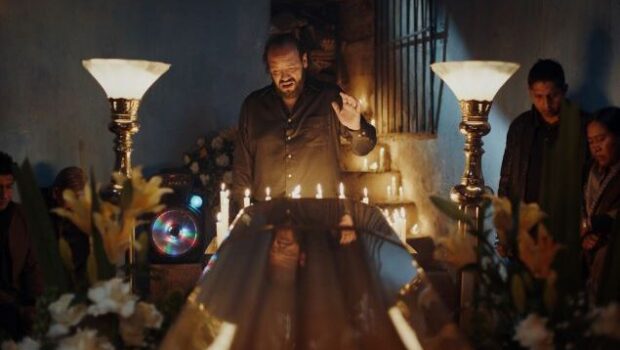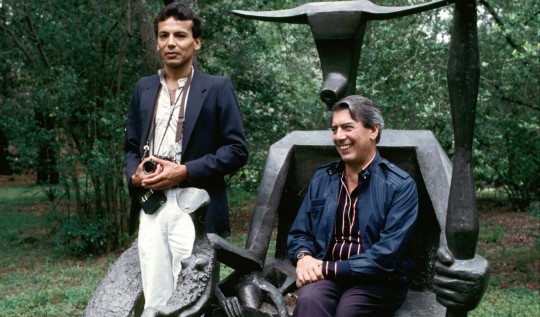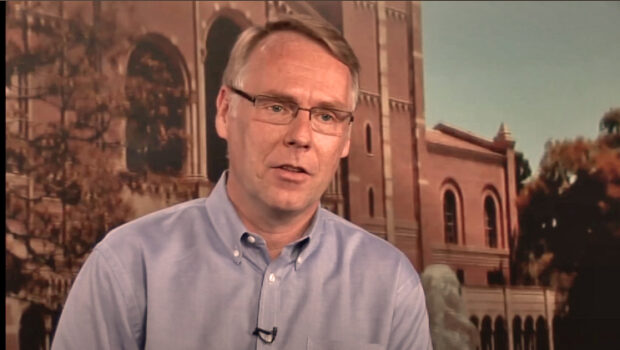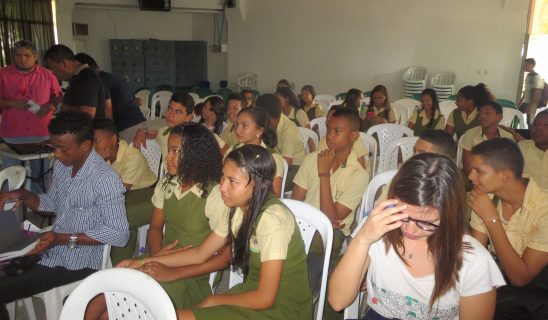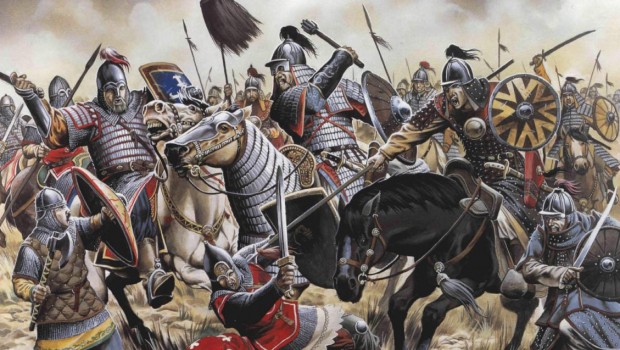El visitante by Martin Bouloq
El visitante de Martin Bouloq
Rose Mary Salum
Translated by Ana Emilia Felker
Bolivian cinema, although relatively less known on the international scene, has experienced significant growth and artistic expression in recent years. One filmmaker who stands out within this scenario is Martín Bouloq. A few weeks ago, we were fortunate to have the director at Literal’s facilities where he spoke with Rodrigo Hasbún, Bolivian writer and screenwriter of El visitante (The Visitor), the film they worked on together. It is important to note that it has been very celebrated: it was in the official selection at the Tribecca Festival, The Latin Wave of the Museum of Fine Arts and Cinema Tropical among many others. Both talked about their experience building together the story that Bouloq would soon bring to the stage.
The conversation was affable, warm. Martin said he was inspired by literature, painting, photography, music and other disciplines for his film career. He started writing literature before making his first short film but the videos came a little later when he knew that film would be his mode of expression. At first his approach was self-taught and intuitive. Later, his formal education and creative impulse led him to draw from real events that he notes down in a collage of events and enrich all aspects of his stories. The joint work between Martin and Rodrigo was developed through endless conversations where the close friendship that unites them led to this magnificent film.
Set in Cochabamba, Bolivia, The Visitor opens with a symbolic scene: Humberto, an ex-convict and father of a teenage girl named Aleida, is released from prison and moves uphill towards what would be the perfect metaphor for what awaits him. His first assignment is to visit his daughter who has been adopted by her maternal grandparents when she was left without any protection: her mother died and her father ended up in the penitentiary. Her maternal grandparents are now running the Evangelist church. Humberto, with the permission of his in-laws, begins to visit his daughter only to be confronted with long silences. The girl does not feel confident to talk during the first few encounters, but as the days pass, the young girl inquires about her past and the reasons why her parents were absent. We intuit that the mother committed suicide and the father, that is, Humberto, went to jail because of his alcoholism. But the long silences that populate the film, are left floating through the images to create a very successful ambiguous atmosphere, that only exalts the curiosity of the viewers so that they, in an active way, complete the story by joining the ends that Bouloq and Hasbún leave us. Thus, the most intriguing events happen off-camera but are contained within the facts that we all access on the screen.
At first, once he has resumed his normal life, Humberto makes a living singing at funerals and later, selling phone cards in order to capitalize and regain custody of Aleida. But there is something that is abysmally anticipated and the protagonist cannot see: the social classes of a divided society are so subtle that only those who observe them can identify them and see that a reconciliation would be impossible. Humberto cannot understand it at that moment, perhaps blinded by his love for his daughter, that the differences are so marked that they are not only evident to the most distracted viewer, but are felt in the flesh at the mere mention of them. The visitor brings us that reality without mentioning it, perhaps also because the only way out of that hell is to join the evangelist church and climb their seats to get out of that black hole that Cochabamba can be.
In that sense, these differences are no stranger to Bolivian cinema either, which often explores themes deeply rooted in the country’s social and political context. Its films tend to address issues such as poverty, inequality, indigenous cultures, historical events and the complexities of Bolivian identity. The stories portrayed on screen are often raw, intimate and reflect the reality of many Bolivians. That which describes Bolivian cinema, marks Bouloq’s work giving it a unique voice within the country’s landscape. His works often show meticulous attention to detail, but above all to metaphor. Towards the end of the film, the visual images become increasingly powerful. We see a character dwarfed by an overwhelming environment. The mountains, the grass, the hills, everything overwhelms him. Humberto is no more than a minimized figure, moving slowly forward. He is on his way to the place where his daughter will be baptized. Aleida, again in the hands of her grandparents, dives into the water and three windmills frame the scene. They represent the three crosses that recall the Golgotha where someone dies and others are reborn. But this return to life does not happen in the hereafter, where the kingdom of heaven is the promise of every evangelist, but in the here and now promoted by the grandparents from the seat of power. Both father and daughter will die a symbolic death and be reborn in that Christian world that does not necessarily promise a better life. What is to come? It remains to be seen. Everything will depend on the imagination. Of the spectator himself, who will have to recreate a story that lengthens like the shadow left by this film, in that imagined future that only art films can leave, films that will remain in time, their own and that of cinematographic history.
Let’s hope that Bouloq’s work continues to rise to the challenge of making quality films from Bolivia and continues to receive the international attention it deserves. His language is metaphorical and powerful and its resonance is universal. His works shed light on social and political issues while celebrating the character and cultural heritage of the Bolivian people. Limited funding and infrastructure, along with the dominance of Hollywood and other international film industries, will always be obstacles to national production, as the director himself and Rodrigo Hasbún, his screenwriter discussed on their visit. Nevertheless, Bouloq’s passion and resilience, Hasbún’s exquisite work, the quality of the performances in El visitante, as well as his vision of human psychology offer hope for the future.
-Fotograma de El visitante
 Rose Mary Salum es la fundadora y directora de Literal, Latin American Voices. Es la autora de Donde el río se toca (Sudaquia, 2022), Otras lunas (Libros del sargento, 2022) Tres semillas de granada, ensayos desde el inframundo (Vaso Roto, 2020), Una de ellas (dislocados, 2020). El agua que mece el silencio (Vaso Roto, 2015), Delta de las arenas, cuentos árabes, cuentos judíos (Literal Publishing, 2013) (Versión Kindle) y Entre los espacios (Tierra Firme, 2003), entre otros títulos. Sus obras se han traducido al inglés, italiano, búlgaro y portugués. Es colaboradora en Hablemos escritoras. Su Twitter es @rosemarysalum
Rose Mary Salum es la fundadora y directora de Literal, Latin American Voices. Es la autora de Donde el río se toca (Sudaquia, 2022), Otras lunas (Libros del sargento, 2022) Tres semillas de granada, ensayos desde el inframundo (Vaso Roto, 2020), Una de ellas (dislocados, 2020). El agua que mece el silencio (Vaso Roto, 2015), Delta de las arenas, cuentos árabes, cuentos judíos (Literal Publishing, 2013) (Versión Kindle) y Entre los espacios (Tierra Firme, 2003), entre otros títulos. Sus obras se han traducido al inglés, italiano, búlgaro y portugués. Es colaboradora en Hablemos escritoras. Su Twitter es @rosemarysalum
©Literal Publishing. Queda prohibida la reproducción total o parcial de esta publicación. Toda forma de utilización no autorizada será perseguida con lo establecido en la ley federal del derecho de autor
Las opiniones expresadas por nuestros colaboradores y columnistas son responsabilidad de sus autores y no reflejan necesariamente los puntos de vista de esta revista ni de sus editores, aunque sí refrendamos y respaldamos su derecho a expresarlas en toda su pluralidad. / Our contributors and columnists are solely responsible for the opinions expressed here, which do not necessarily reflect the point of view of this magazine or its editors. However, we do reaffirm and support their right to voice said opinions with full plurality.
El cine boliviano, aunque relativamente menos conocido en el escenario internacional, ha experimentado un importante crecimiento y expresión artística en los últimos años. Un cineasta que sobresale dentro de este escenario es Martín Bouloq. Hace algunas semanas, tuvimos la suerte de tener al director en las instalaciones de Literal donde conversó con Rodrigo Hasbún, escritor Boliviano y el guionista de El visitante, la película en la que trabajaron en conjunto. Es importante señalar que ha sido muy celebrada: fue selección official en el Festival de Tribecca, El Latin Wave del Museum of Fine Arts y Cinema Tropical entre otros tantos. Ambos platicaron acerca de su experiencia al construir juntos la historia que pronto llevaría a escena Bouloq.
La conversación transcurrió afable, cálida. Martin dijo haberse inspirado en la literatura, la pintura, la fotografía, la música y otras disciplinas para su carrera cinematográfica. Empezó escribiendo literatura antes de realizar su primer cortometraje pero los videos llegaron un poco después cuando supo que el cine sería su modo de expresión. Al principio su aproximación fue autodidacta e intuitiva. Después, su educación formal y el impulso creativo, lo llevó a nutrirse de sucesos reales que anota en un collage de eventos y enriquecer todos los aspectos de sus historias. El trabajo conjunto entre Martin y Rodrigo se fue desarrollando a base de infinitas conversaciones donde la estrecha amistad que los une desembocó en esta magnífica película.
Ambientada en Cochabamba, Bolivia, El Visitante inicia con una escena simbólica: Humberto, un exconvicto y padre de una chica adolescente llamada Aleida, sale de la cárcel y avanza cuesta arriba hacia lo que sería la metáfora perfecta de lo que le espera. Su primera encomienda es la de ir a visitar a su hija quien ha sido adoptada por sus abuelos maternos cuando se quedó sin protección alguna: su madre murió y su padre acabó en el encierro. Sus abuelos maternos ahora se encuentran dirigiendo la iglesia Evangelista. Humberto, con el permiso de sus suegros, comienza a visitar a su hija solo para enfrentarse a largos silencios. La chica no se siente con la confianza de hablar durante los primeros encuentros, pero conforme pasan los días, la jovencita indaga sobre su pasado y las razones por las cuales sus padres se ausentaron. Intuimos que la madre cometió un suicidio y el padre, es decir, Humberto, llegó a la cárcel debido a su alcoholismo. Pero los largos silencios que pueblan la película, quedan flotando a través de las imágenes para crear un ambiente de ambigüedad tan lograda, que solo exalta la curiosidad de los espectadores para que ellos, de modo activo, completen la historia a base de unir los cabos que nos van dejando Bouloq y Hasbún. Así los sucesos más intrigantes suceden fuera de cámara pero están contenidos dentro de los hechos a los que todos accedemos en la pantalla.
En un principio, una vez retomada su vida normal, Humberto se gana la vida cantando en funerales y más tarde, vendiendo tarjetas de teléfono para poder capitalizarse y recuperar la custodia de Aleida. Pero hay algo que se anticipa de forma abismal y el protagonista no puede ver: las clases sociales de una sociedad dividida son tan sutiles, que solo los que observan las pueden identificar y ver que una conciliación sería imposible. Humberto no puede entender en ese momento, quizá cegado por el amor a su hija, que las diferencias son tan marcadas, que no solo quedan en evidencia al espectador más distraído sino que se sienten en carne propia de tan solo mencionarse. El visitante nos trae esa realidad sin mencionarla, quizá también porque la única brecha para salir de ese infierno sea la de integrarse a la iglesia evangelista y escalar sus escaños para salir de ese hoyo negro que puede ser Cochabamba.
En ese sentido, estas diferencias tampoco le son ajenas al cine boliviano que a menudo explora temas profundamente arraigados en el contexto social y político del país. Sus películas tienden a abordar temas como la pobreza, la desigualdad, las culturas indígenas, los acontecimientos históricos y las complejidades de la identidad boliviana. Las historias retratadas en la pantalla suelen ser crudas, íntimas y reflejan la realidad de muchos bolivianos. Eso que describe al cine boliviano, marca el trabajo de Bouloq dándole una voz única dentro del panorama del país. Sus obras a menudo muestran una meticulosa atención al detalle, pero sobretodo a la metáfora. Hacia el final de la película, las imágenes visuales se van volviendo más poderosas. Vemos a un personaje empequeñecido por un entorno aplastante. Las montañas, el pasto, las colinas, todo lo supera. Humberto no es más que una figura minimizada que avanza con lentitud. Se dirige al lugar donde bautizarán a su hija. Aleida, de nuevo en manos de los abuelos, se sumerge en el agua y tres molinos de viento enmarcan la escena. Representan las tres cruces que recuerdan al Golgota en donde alguien muere y otros renacen. Pero esa vuelta a la vida, no sucede en el más allá, donde el reino de los cielos es la promesa de todo evangelista, sino en el aquí y el ahora que promueven los abuelos desde la silla del poder. Ambos, tanto el padre como la hija, tendrán una muerte simbólica y renacerán en ese mundo cristiano que no necesariamente promete una vida mejor. ¿Lo que viene? Está por verse. Todo dependerá de la imaginación. Del propio espectador que tendrá que recrear una historia que se alarga como la sombra que ha dejado esta película, en ese futuro imaginado que solo pueden dejar las películas de arte que permanecerán en el tiempo, el propio y el de la historia cinematográfica.
Esperemos que el trabajo de Bouloq siga superando el desafío que significa hacer cine de calidad desde Bolivia y continue recibiendo la atención internacional que se merece. Su lenguaje es metafórico y poderoso y su resonancia es universal. Sus obras arrojan luz sobre cuestiones sociales y políticas mientras celebran el carácter y el patrimonio cultural del pueblo boliviano. La financiación y la infraestructura limitadas, junto con el dominio de Hollywood y otras industrias cinematográficas internacionales, siempre serán obstáculos para la producción nacional, como el mismo director y Rodrigo Hasbún, su guionista lo discutieron en su visita. No obstante, la pasión y la resiliencia de Bouloq, el trabajo exquisito de Hasbún, la calidad de las actuaciones de El visitante, así como su visión de la sicología humana ofrecen esperanza para el futuro.
-Fotograma de El visitante
 Rose Mary Salum es la fundadora y directora de Literal, Latin American Voices. Es la autora de Donde el río se toca (Sudaquia, 2022), Otras lunas (Libros del sargento, 2022) Tres semillas de granada, ensayos desde el inframundo (Vaso Roto, 2020), Una de ellas (dislocados, 2020). El agua que mece el silencio (Vaso Roto, 2015), Delta de las arenas, cuentos árabes, cuentos judíos (Literal Publishing, 2013) (Versión Kindle) y Entre los espacios (Tierra Firme, 2003), entre otros títulos. Sus obras se han traducido al italiano, búlgaro y portugués. Su Twitter es @rosemarysalum
Rose Mary Salum es la fundadora y directora de Literal, Latin American Voices. Es la autora de Donde el río se toca (Sudaquia, 2022), Otras lunas (Libros del sargento, 2022) Tres semillas de granada, ensayos desde el inframundo (Vaso Roto, 2020), Una de ellas (dislocados, 2020). El agua que mece el silencio (Vaso Roto, 2015), Delta de las arenas, cuentos árabes, cuentos judíos (Literal Publishing, 2013) (Versión Kindle) y Entre los espacios (Tierra Firme, 2003), entre otros títulos. Sus obras se han traducido al italiano, búlgaro y portugués. Su Twitter es @rosemarysalum
©Literal Publishing. Queda prohibida la reproducción total o parcial de esta publicación. Toda forma de utilización no autorizada será perseguida con lo establecido en la ley federal del derecho de autor
Las opiniones expresadas por nuestros colaboradores y columnistas son responsabilidad de sus autores y no reflejan necesariamente los puntos de vista de esta revista ni de sus editores, aunque sí refrendamos y respaldamos su derecho a expresarlas en toda su pluralidad. / Our contributors and columnists are solely responsible for the opinions expressed here, which do not necessarily reflect the point of view of this magazine or its editors. However, we do reaffirm and support their right to voice said opinions with full plurality.


